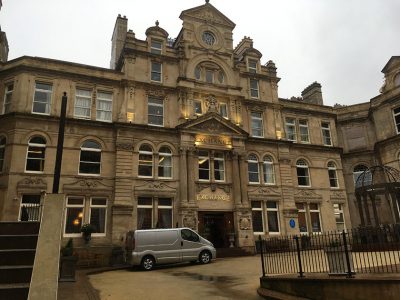Redevelopment is not the one for creating an urban culture in Cardiff but it could at least be aesthetically pleasing and reflect the history of Cardiff. So here’s where they got it right and spectacularly wrong.
Penarth Pier: retained the historical features and maintained it’s original uses.
Altolusso Tower: perhaps the worst example of restoration anyone has ever had the misfortune to see or be involved in. A shocking attempt to keep the original façade of the Cardif Gas Light and Coke Co building with a monstrosity of a concrete residential block placed inelegantly behind it.
Redevelopment strikes Cardiff again, this time to create an ‘urban’ arts centre of the old Tramshed, but is corporate development preventing our city becoming an urban culture hub?
The Tramshed is the latest in Cardiff’s historical architecture to be gutted out and transformed into a money making machine, this time an ‘urban arts centre’. The Tramshed has already been used for an art gallery in 2013 and the owners want to expand this to add a dance studio, restaurants, office space and business development units.
There appears to be a move to create an ‘urban’ culture for Cardiff with the redevelopment of the Tramshed but the vital flaw in this plan for an edgy side to our city is that a fancy building can’t be built by a corporate body to create a culture that is innately bred from the people. Grayson Perry was quoted in The Independent recently saying that “rich people don’t create culture” and although he was talking about London the principle applies across the world.
The so-called ghettoized areas where the ‘poor’ people of Cardiff live are slowly being torn down, next to go is Butetown, the area directly inland from the Bay. Proposals have been made to tear down the current industrial buildings for a row of apartment blocks (including some affordable housing) and shops. Many of which are likely to be the standard chain stores seen on every high street, a continuation of the mundane albeit economically successful bay area.
Last year alone the Bay bought in £5.6bn in tourist spend, more than trumping the cost to actually create it (£2.4bn) and a vast proportion of this was spent on eating out. But does it matter if this money was spent funding large corporate businesses that don’t create variety and a cultural identity for a city that so clearly needs one? Apparently so if Cardiff is serious about becoming an ‘urban’ hub.
The Bank Vaults in the Bay is perhaps the only exception to the standardisation of our city. It’s now being used as a club at least once a month by Cellar Door and Catapult Records; drawing in the young and interesting from across South Wales and beyond. If it’s urban culture that Cardiff councilors want then it is through encouraging the use of abandoned buildings for cultural events which draw in artists, musicians and the like, and bringing it’s own brand of urban culture with it.
It’s these abandoned buildings, which reflect the interesting history of Cardiff, and the main idea of the Bay area was to create historical interest to draw in more visitors. And it seems to have worked. The Bay is the most visited spot in the city; in 2011 it attracting just over 1 million visitors and 27% of those were visiting for historic interest. It appears that developers should focus on this kind of redevelopment in order to draw in more tourists in the future.
The idea of the Tramshed is similar to the Bay to increase the economy and the Developer Simon Baston has said that the Tramshed development will “stimulate economic development and provide a building which will act as a catalyst/magnet to help underpin and grow the urban cultural position in Cardiff.” It’s now a case of whether the Tramshed can be economically viable as well as an urban hub.
The Property Problem
Looking back at the tramshed, the idea to turn it into an urban arts centre suggests that the people of Cardiff have listened to Patti Smith’s warning, restoring a historic building to a venue that everyone can visit and use. Or so it appears on plans. But the addition of flats, office space and restaurants suggest that it is still all about the property developers.
The Bay development has had major issues associated with housing: far too many luxury flats were built for a young professional market and as of 2008 a third of these were still empty. The need of the residents was neglected to make way for a development that was not necessarily in the name of the locals.
Whatever happened to bohemia?
The main problem is that all the redevelopment is drawing the young, bohemian people away from the city and to other pastures such as Bristol, Manchester and London. They arrive in Cardiff as students but past their degree the city just doesn’t offer enough in terms of art and media based careers to keep them here, meaning that ‘urban’ culture that they create dies when they leave.
If Cardiff is truly serious in becoming an urban arts hub then it’s council needs to stop selling off historical buildings to property developers who go against the ideologies of the ‘urban’ artists and music that the city is trying to attract. Perhaps it should stick to what it does best: history and preserving the architecture in the best way they can to draw in the money from history hunting punters.
Redevelopment is not the one for creating an urban culture in Cardiff but it could at least be aesthetically pleasing and reflect the history of Cardiff. So here’s where they got it right and spectacularly wrong.
Penarth Pier: retained the historical features and maintained it’s original uses.
Altolusso Tower: perhaps the worst example of restoration anyone has ever had the misfortune to see or be involved in. A shocking attempt to keep the original façade of the Cardif Gas Light and Coke Co building with a monstrosity of a concrete residential block placed inelegantly behind it.






